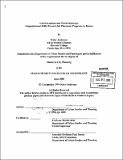| dc.contributor.advisor | Martin Rein. | en_US |
| dc.contributor.author | Anderson, Dulcy, 1970- | en_US |
| dc.contributor.other | Massachusetts Institute of Technology. Dept. of Urban Studies and Planning. | en_US |
| dc.coverage.spatial | n-us-ma | en_US |
| dc.date.accessioned | 2011-05-23T17:51:24Z | |
| dc.date.available | 2011-05-23T17:51:24Z | |
| dc.date.copyright | 1999 | en_US |
| dc.date.issued | 2000 | en_US |
| dc.identifier.uri | http://hdl.handle.net/1721.1/62949 | |
| dc.description | Thesis (M.C.P.)--Massachusetts Institute of Technology, Dept. of Urban Studies and Planning, June 2000. | en_US |
| dc.description | Includes bibliographical references (p. 76-79). | en_US |
| dc.description.abstract | Federal welfare-to-work legislation (the Personal Responsibility and Work Opportunity Act of 1996 and related federal grants) and the anticipation of the consolidation of job training programs through the Workforce Investment Act of 1998 have created new relationships amongst local government, for-profit and non-profit sectors. Related shifts toward work-oriented programs in public housing (through the Quality Housing and Work Responsibility Act of 1998) and facilitation of work for those with disabilities (through the Ticket to Work and Work Incentives Improvement Act of 1999) are also involved in this transition. Together, the new public/private mix is expanding "job readiness" services, childcare, private-sector involvement in training of the low-wage labor force, and coordination of welfare, unemployment and reemployment initiatives. The reconfiguration also seems to be fundamentally bluffing the boundaries between traditionally male-based job training and unemployment insurance and traditionally female-based aid for families and related services. In addition to a blurring of the boundaries between male and female systems of aid, there seems at times to be an implicit recognition of the blurred boundaries between the working-poor and welfare recipients. This paper explores the work of several organizations in Boston that have received Department of Labor (F/S) Welfare-to-Work grants. While the Welfare-to- Work grants are a time-limited source of funding (established in 1998 and scheduled to end in FY2001), they have served as a catalyst for organizational changes in ways that seem likely to be lasting and they seem to be paradigmatic of the sort of incentives and programs that are coming out of combined Health and Human Services and Department of Labor programming that seek to employ "hard-to-place" populations. By considering organizations that have received this funding and their relationships to city and state agencies, the for-profit sector, and other organizations in the not-for-profit sector, this paper creates a "map" of some of the important public and private institutions involved in the welfare-to-work transition in Boston. It also suggests the impacts of legislative changes on the evolving trajectories of individual organizations. | en_US |
| dc.description.statementofresponsibility | by Dulcy Anderson. | en_US |
| dc.format.extent | 82 p. | en_US |
| dc.language.iso | eng | en_US |
| dc.publisher | Massachusetts Institute of Technology | en_US |
| dc.rights | M.I.T. theses are protected by
copyright. They may be viewed from this source for any purpose, but
reproduction or distribution in any format is prohibited without written
permission. See provided URL for inquiries about permission. | en_US |
| dc.rights.uri | http://dspace.mit.edu/handle/1721.1/7582 | en_US |
| dc.subject | Urban Studies and Planning. | en_US |
| dc.title | Career ladders and work pathways : organizational shifts toward job-placement programs in Boston | en_US |
| dc.type | Thesis | en_US |
| dc.description.degree | M.C.P. | en_US |
| dc.contributor.department | Massachusetts Institute of Technology. Department of Urban Studies and Planning | |
| dc.identifier.oclc | 47912329 | en_US |
